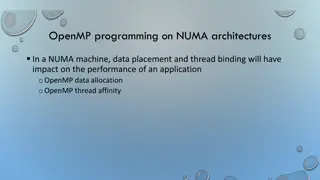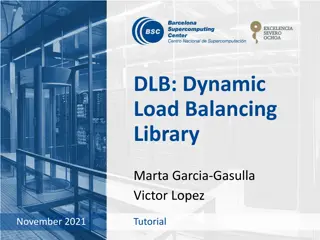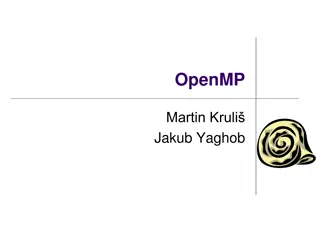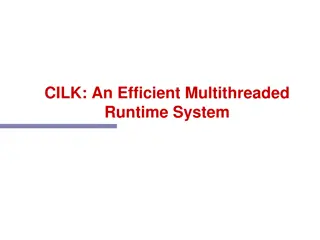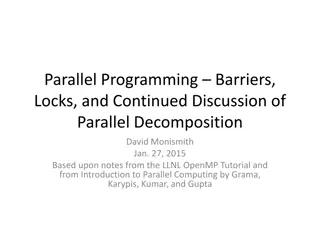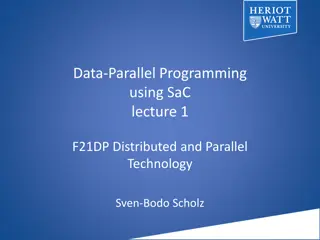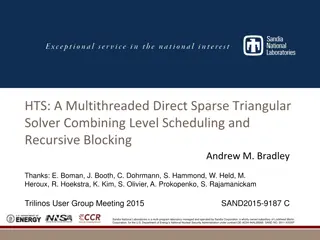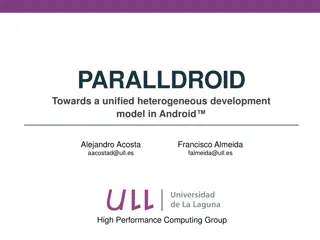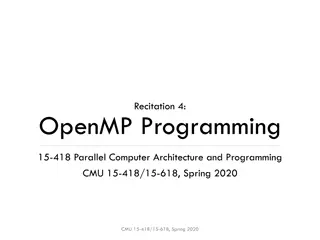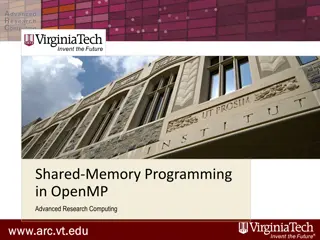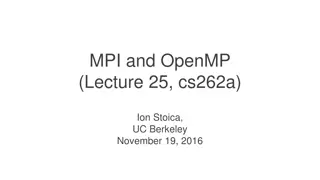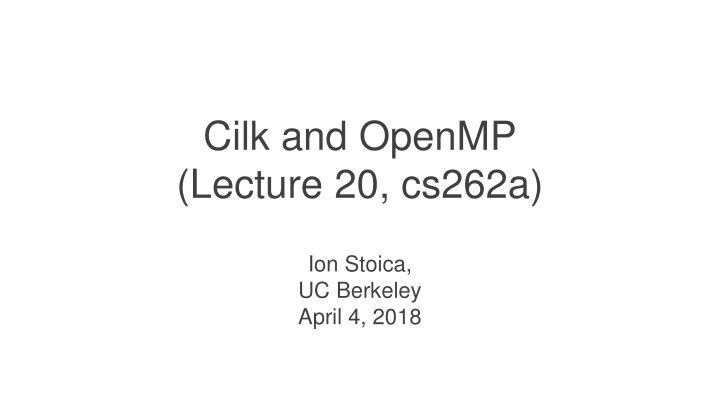
Cilk and OpenMP in Multithreaded Programming
Explore the concepts of Cilk and OpenMP in the realm of multithreaded programming, covering topics such as shared memory, message passing, different architectures, motivation for multicore CPUs, challenges of multithreading, and examples of parallelizing code.
Download Presentation

Please find below an Image/Link to download the presentation.
The content on the website is provided AS IS for your information and personal use only. It may not be sold, licensed, or shared on other websites without obtaining consent from the author. If you encounter any issues during the download, it is possible that the publisher has removed the file from their server.
You are allowed to download the files provided on this website for personal or commercial use, subject to the condition that they are used lawfully. All files are the property of their respective owners.
The content on the website is provided AS IS for your information and personal use only. It may not be sold, licensed, or shared on other websites without obtaining consent from the author.
E N D
Presentation Transcript
Cilk and OpenMP (Lecture 20, cs262a) Ion Stoica, UC Berkeley April 4, 2018
Todays papers Cilk: An Efficient Multithreaded Runtime System by Robert D. Blumofe, Christopher F. Joerg, Bradley C. Kuszmaul, Charles E. Leiserson, Keith H. Randall and Yuli Zhou http://supertech.csail.mit.edu/papers/PPoPP95.pdf OpenMP: An IndustryStandard API for SharedMemory Programming , Leonardo Dagum and Ramesh Menon https://ucbrise.github.io/cs262a-spring2018/
Message passing vs. Shared memory Client Client Client Client send(msg) recv(msg) send(msg) recv(msg) MSG MSG Shared Memory MSG IPC Shared memory: all multiple processes to share data via memory Message passing: exchange data explicitly via IPC Applications must locate and and map shared memory regions to exchange data Application developers define protocol and exchanging format, number of participants, and each exchange
Architectures Uniformed Shared Memory (UMA) Cray 2 Non-Uniformed Shared Memory (NUMA) SGI Altix 3700 Massively Parallel DistrBluegene/L Orthogonal to programming model
Motivation Multicore CPUs are everywhere: Servers with over 100 cores today Even smartphone CPUs have 8 cores Multithreading, natural programming model All processors share the same memory Threads in a process see same address space Many shared-memory algorithms developed
But Multithreading is hard Lots of expertise necessary Deadlocks and race conditions Non-deterministic behavior makes it hard to debug
Example Parallelize the following code using threads: for (i=0; i<n; i++) { sum = sum + sqrt(sin(data[i])); } Why hard? Need mutex to protect the accesses to sum Different code for serial and parallel version No built-in tuning (# of processors?)
Cilk Based on slides available at http://supertech.csail.mit.edu/cilk/lecture-1.pdf
Cilk A C language for programming dynamic multithreaded applications on shared-memory multiprocessors Examples: dense and sparse matrix computations n-body simulation heuristic search graphics rendering
Cilk in one slide Simple extension to C; just three three basic keywords Cilk programs maintain serial semantics Abstracts away parallel execution, load balancing and scheduling Parallelism Processor-oblivious Speculative execution Provides performance guarantees
Example: Fibonacci C (elision) Click int fib (int n) { if (n<2) return (n); else { int x,y; x = fib(n-1); y = fib(n-2); return (x+y); } } cilk int fib (int n) { if (n<2) return (n); else { int x,y; x = spawn fib(n-1); y = spawn fib(n-2); sync return (x+y); } } A Cilk program s serial elision is always a legal implementation of Cilk semantics Cilk provides no new data types.
Cilk basic kewords Identifies a function as a Cilk procedure, capable of being spawned in parallel. click int fib (int n) { if (n<2) return (n); else { int x,y; x = spawn fib(n-1); y = spawn fib(n-2); sync return (x+y); } } The named child Cilk procedure can execute in parallel with the parent caller Control cannot pass this point until all spawned children have returned
Dynamic multithreading example: fib(4) 4 click int fib (int n) { if (n<2) return (n); else { int x,y; x = spawn fib(n-1); y = spawn fib(n-2); sync return (x+y); } } Initial thread Computation unfolds dynamically
Dynamic multithreading example: fib(4) 4 click int fib (int n) { if (n<2) return (n); else { int x,y; x = spawn fib(n-1); y = spawn fib(n-2); sync return (x+y); } } Initial thread Execution represented as a graph, G = (V, E) Each vertex v V represents a (Cilk) thread: a maximal sequence of instructions not containing parallel control (spawn, sync, return) Every edge e E is either a spawn, a return or a continue edge
Dynamic multithreading example: fib(4) 4 Spawn edge click int fib (int n) { if (n<2) return (n); else { int x,y; x = spawn fib(n-1); y = spawn fib(n-2); sync return (x+y); } } 3
Dynamic multithreading example: fib(4) Continue edge 4 click int fib (int n) { if (n<2) return (n); else { int x,y; x = spawn fib(n-1); y = spawn fib(n-2); sync return (x+y); } } 2 3
Dynamic multithreading example: fib(4) 4 click int fib (int n) { if (n<2) return (n); else { int x,y; x = spawn fib(n-1); y = spawn fib(n-2); sync return (x+y); } } 2 3 2 1 1 1
Dynamic multithreading example: fib(4) 4 click int fib (int n) { if (n<2) return (n); else { int x,y; x = spawn fib(n-1); y = spawn fib(n-2); sync return (x+y); } } 2 3 2 1 1 1 1 1
Dynamic multithreading example: fib(4) 4 click int fib (int n) { if (n<2) return (n); else { int x,y; x = spawn fib(n-1); y = spawn fib(n-2); sync return (x+y); } } 2 3 2 1 1 1 Return edge 1 1
Dynamic multithreading example: fib(4) 4 click int fib (int n) { if (n<2) return (n); else { int x,y; x = spawn fib(n-1); y = spawn fib(n-2); sync return (x+y); } } 2 3 2 1 1 1 1 1
Dynamic multithreading example: fib(4) 4 click int fib (int n) { if (n<2) return (n); else { int x,y; x = spawn fib(n-1); y = spawn fib(n-2); sync return (x+y); } } Final thread 2 3 2 1 1 1 1 1
Cactus stack A stack pointer can be passed from parent to child, but not from child to parent Support several views of stack Cilk also supports malloc D B A E C A A A A A A C B B B B C E D D E
Algorithmic complexity TP = execution time on P processors
Algorithmic complexity TP = execution time on P processors T1 = total work
Algorithmic complexity TP = execution time on P processors T1 = total work TC = critical path length (span)
Algorithmic complexity TP = execution time on P processors T1 = total work TC = critical path length (span) Lower bounds TP >= T1/P TP >= TC
Speedup T1/TP= speedup on P processors. If T1/TP = (P) <= P, linear speedup If T1/TP = P , perfect linear speedup
Parallelism Since TP >= TC , T1/TC is maximum speedup T1/TP= prallelism, average amount of work per step along the span
Example: fib(4) Assume each thread takes 1 time unit: Work: T1 = 17 Span: TC = 8 Parallelism: T1/TC = 17/8 8 1 7 2 3 4 6 Little sense to use more than 2 processors! 5
Example: vector addition void vadd (real *A, real *B, int n){ int i; for (i=0; i<n; i++) A[i]+=B[i]; }
Example: vector addition void vadd (real *A, real *B, int n){ int i; for (i=0; i<n; i++) A[i]+=B[i]; } Key idea: convert loops to recursion..
Example: vector addition void vadd (real *A, real *B, int n){ int i; for (i=0; i<n; i++) A[i]+=B[i]; } Key idea: convert loops to recursion.. void vadd (real *A, real *B, int n){ if (n<=BASE) { int i; for (i=0; i<n; i++) A[i]+=B[i]; } else { vadd (A, B, n/2); vadd (A+n/2, B+n/2, n-n/2); } }
Example: vector addition cilk void vadd (real *A, real *B, int n){ if (n<=BASE) { int i; for (i=0; i<n; i++) A[i]+=B[i]; } else { spawn vadd (A, B, n/2); spawn vadd (A+n/2, B+n/2, n-n/2); sync; } } BASE
Example: vector addition Assume BASE = (1): Work: T1= (n) Span: TC= (log n) Parallelism: T1/TC= (n/log n) BASE
Scheduling Cilk scheduler maps Cilk threads onto processors dynamically at runtime P P P Network Memory I/O
Greedy scheduling Key idea: Do as much as possible on every step Definition: A thread is ready if all its predecessors have executed
Greedy sechduling P = 3 Key idea: Do as much as possible on every step Definition: A thread is ready if all its predecessors have executed Complete step If # ready threads >= P, run any P ready threads
Greedy scheduling P = 3 Key idea: Do as much as possible on every step Definition: A thread is ready if all its predecessors have executed Complete step If # ready threads >= P, run any P ready threads Incomplete step If # ready threads < P run all P ready threads
Greedy-Scheduling Theorem Theorem[Graham 68 & Brent 75] Any greedy scheduler achieves TP T1/P + TC P = 3 Proof sketch: # complete steps T1/P since each complete step performs P work
Greedy-Scheduling Theorem Theorem[Graham 68 & Brent 75] Any greedy scheduler achieves TP T1/P + TC P = 3 Proof sketch: # complete steps T1/P since each complete step performs P work # incomplete steps TC, since each incomplete step reduces the span of the unexecuted DAG by 1
Optimality of greedy Corollary: Any greedy scheduler is within a factor of 2 of optimal Proof: Let TP* be execution time produced by optimal scheduler Since TP* max{T1/P, TC} (lower bounds), we have TP T1/P + TC 2 max{T1/P, TC} 2 TP*
Linear speedup Corollary: Any greedy scheduler achieves near-perfect linear speedup whenever P << T1/TC. Proof: From P << T1/TC we get TC << T1/P From the Greedy Scheduling Theorem gives us TP T1/P + TC T1/P Thus, speedup is T1/TP P
Work stealing Each processor has a queue of threads to run A spawned thread is put on local processor queue When a processor runs out of work, it looks at queues of other processors and "steals" their work items Typically pick the processor from where to steal randomly
Cilk performance Cilk s work-stealing scheduler achieves TP = T1/P + O(TC) expected time (provably); TP T1/P + O(TC) time (empirically). Near-perfect linear speedup if P << T1/TC Instrumentation in Cilk allows to accurately measure T1 and TC The average cost of a spawn in Cilk-5 is only 2 6 times the cost of an ordinary C function call, depending on the platform
Summary C extension for multithreaded programs Now available also for C++: Cilk Plus from Intel Simple; only three keywords: cilk, spawn, sync Cilk Plus has actually only two: cilk_spaw, cilk_sync Equivalent to serial program on a single core Abstracts away parallelism, load balancing and scheduling Leverages recursion pattern Might need to rewrite programs to fit the pattern (see vector addition example)
OpenMP Based on the Introduction to OpenMP presentation: (https://webcourse.cs.technion.ac.il/236370/Spring2009/ho/WCFiles/OpenMPLecture.ppt)
OpenMP A language extension with constructs for parallel programming: Critical sections, atomic access, private variables, barriers Parallelization is orthogonal to functionality If the compiler does not recognize OpenMP directives, the code remains functional (albeit single-threaded) Industry standard: supported by Intel, Microsoft, IBM, HP
OpenMP execution model Fork and Join: Master thread spawns a team of threads as needed Worker Thread FORK FORK FORK FORK Master thread Master thread JOIN JOIN JOIN JOIN Parallel regions
OpenMP memory model Shared memory model Threads communicate by accessing shared variables The sharing is defined syntactically Any variable that is seen by two or more threads is shared Any variable that is seen by one thread only is private Race conditions possible Use synchronization to protect from conflicts Change how data is stored to minimize the synchronization
OpenMP: Work sharing example answer1 = long_computation_1(); answer2 = long_computation_2(); if (answer1 != answer2) { } How to parallelize?



